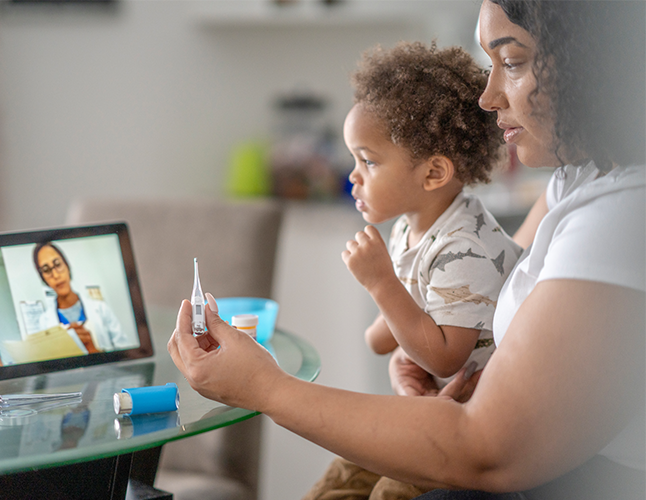Hospitals across the country continue facing significant post-pandemic challenges. From labor shortages to supply chain disruptions to skyrocketing expenses, hospitals have had to look for new and innovative ways to maintain high-quality care and financial viability.
This is particularly true for pediatric hospitals. While facing all the same challenges as general hospitals, they’re also experiencing growing volumes due to the shuttering of pediatric units nationwide. Many hospitals have chosen to cut pediatric services to make room for more “lucrative” adult services. This has put even greater pressure on pediatric hospitals as they struggle to manage higher volumes with limited staff.
As pediatric hospitals work hard to adapt to our “new normal,” they need to take stock of all the ways virtual care solutions can help in this endeavor. Implementing a virtual care platform (VCP) can help.
What is a virtual care platform?
A VCP is an efficient, integrated, secure platform for digital patient and provider communication. A VCP enables timely, complete access to patient data across the enterprise. This creates a seamless patient experience that includes everything from scheduling to consent management to virtual waiting rooms, secure messaging, and more.
What are the benefits of a virtual care platform?
There are many benefits of a VCP that pediatric hospitals can benefit from. The most significant is that it allows more effective communication and care collaboration between clinicians, the patient, and the patient’s parents regardless of location. Besides a positive impact on outcomes, a VCP can help pediatric hospitals expand their services and reach more children in need.
A virtual care platform increases access to care while enabling pediatric hospitals to expand their service area and see more children without adding or staffing new physical locations.
The following are five use cases for leveraging a VCP in a pediatric hospital.

NICU/PICU
A VCP enables pediatric hospitals to create a centralized NICU/PICU monitoring station where clinicians can safely watch over multiple children in multiple locations from a single “command center.” When an issue arises, onsite clinicians can be quickly notified. Bedside carts equipped with digital stethoscopes, Horus scopes, and other devices enable remote providers to monitor a child’s vitals and other physical attributes continuously. This allows prompt intervention for high-risk cases.
eClinic
Access to care is a growing problem in the U.S., especially as rural facilities are closing at an alarming rate. Forty-six million Americans live in rural areas, a fourth of whom say there are times when they’ve been unable to access the care they need. By leveraging a VCP, pediatric hospitals can establish an EClinic to bring much-needed care to children living in rural areas and to those facing mobility or transportation barriers.
School telehealth
Fewer than half of our nation’s schools have a full-time nurse. One in four have no nurse at all. A VCP can mitigate this growing shortage and bring care to school children across the country. With real-time telehealth capabilities on site, pediatric hospitals can quickly assess, triage, diagnose, and refer students to the appropriate resource remotely. In this way, pediatric hospitals can reach more children with fewer clinicians.
First responder
A VCP enables more effective remote triage and assessments while the child is still in the ambulance. Using telehealth technology over a VCP, specialists or emergency physicians can collaborate in real time with the EMT. Tests can be ordered before the child’s arrival at the hospital, allowing the patient to head straight to imaging without having to be reassessed.
Remote patient monitoring
One of the most valuable use cases for a VCP is remote patient monitoring (RPM). With a VCP, pediatric hospitals can develop multiple use cases within pediatric disease management and enable more effective management of these conditions while reducing costs and improving the care experience for children and their parents.
Easy to get started
One of the most significant benefits of a VCP is that it doesn’t require huge investments in vast IT infrastructure. With a VCP, all clinicians can seamlessly access the same data through a single system within their existing clinical workflows. This enables more effective real-time collaboration with other clinicians, the patient, and the patient’s family, no matter their location.

How to choose a VCP
A VCP is about more than video and audio equipment. The best VCPs are integrated solutions that enable better, more seamless care experiences across the continuum. When looking for a solution, pediatric hospitals should choose one that offers real-time virtual communication tools that integrate into their existing systems. This can help reduce the learning curve and improve clinician adoption, which means a faster return on investment. Other features to look for include:
- Expanded video capability with turnkey functionality that enables more effective collaboration between providers, specialists, and children and their parents
- Minimal configuration requirements with the ability to quickly scale to meet fluctuating volume
- Ability to leverage existing video and audio equipment
- Fully structured workflows that drive efficiency and support clinician collaboration
- Intuitive functionality that makes it easy for providers, patients, and the patient’s parents to connect
A VCP allows pediatric providers and care teams to effectively collaborate on a child’s care by giving them access to the information they need—within a structured clinical workflow—at the moment it’s needed. It enables virtual teams to schedule, triage, and provide video encounters between themselves, their patients, and the patient’s family. The result is improved outcomes, lower costs, and a better care experience. VidyoHealth can help.
The VidyoHealth Virtual Care Platform is the flexible, scalable, and intuitive solution pediatric hospitals need to meet today’s growing challenges. The VidyoHealth Virtual Care Platform enables pediatric hospitals to deliver fast, easy, and reliable virtual care experiences to our most vulnerable population—our children.
To learn how your pediatric hospital can benefit from the VidyoHealth Virtual Care Platform, visit https://www.vidyohealth.com/solutions/virtual-care-platform.
